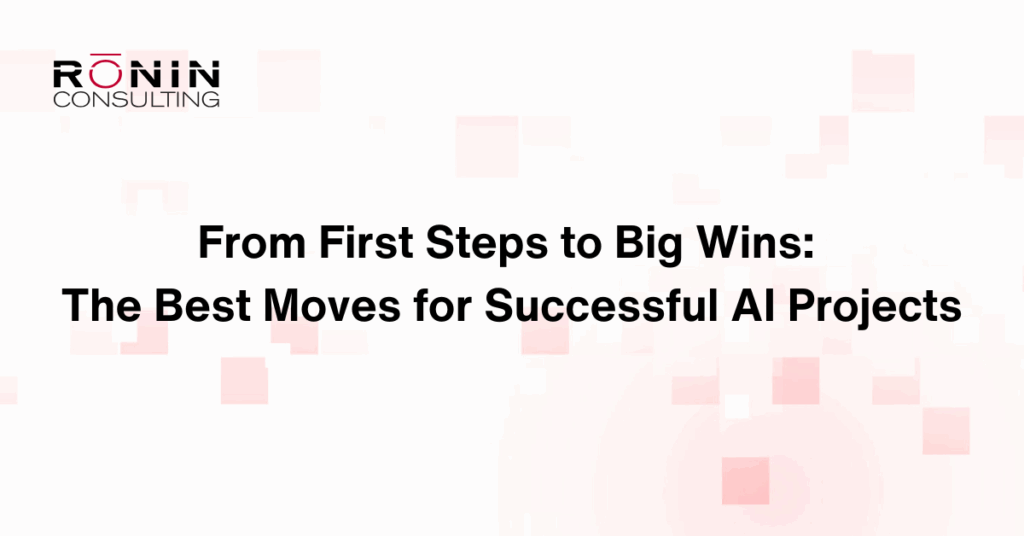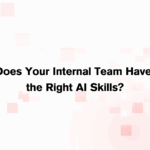
AI is everywhere right now, and tech leaders are under pressure to show progress. For many, this is uncharted territory. They’re delivering their first AI-powered capabilities without a long history of successful AI to draw from.
This is where a common trap appears:
“If we’re going to implement AI, let’s make it big and transformational.”
It’s an understandable instinct. Large-scale projects are familiar territory in enterprise IT, and they can make a compelling case to the board. But AI is different, and starting with an all-in-first AI approach often introduces risks that stall momentum before results are delivered:
- Too complex, too soon. Multiple use cases in one build stretch teams thin, especially while they’re still learning AI development patterns.
- Data readiness gaps. Early projects often expose fragmented or messy data that can’t be “fixed in flight.”
- Unclear outcomes. Without a narrow, measurable goal, progress is hard to prove.
- Adoption challenges. Rolling out a massive system before smaller successes are proven creates resistance.
For leaders starting their AI journey, the smarter play is small, high-value wins that prove capability and build trust, then scaling into more ambitious territory.
Why “one big AI project” sounds good, but rarely works
On the surface, this idea has strong appeal.
It promises efficiency and transformation in one bold move.
“Why tackle ten different problems when you can build one innovative system to solve them all?” is a delicious-sounding bait.
Unfortunately, it can also be a direct route to a breakdown with your AI initiative, and here’s why:
Too complex, too fast. Trying to solve multiple use cases in one build overwhelms even well-resourced teams.
Disconnected data. Most companies still struggle with a combination of siloed, structured, and unstructured data. Feeding these data sources into a single AI system without spending time to clean the data can create unreliable results.
Lofty goals. When a project tries to solve “everything,” it often lacks a clear success metric or ownership path.
Poor change management. Rolling out large systems across departments without incremental adoption creates friction and confusion.
Instead of delivering that promised “big win,” projects with this type of scope can stall midway. The takeaway here is that one project to rule them all might sound flashy in the boardroom, but in the trenches, they are hard to execute, harder to adopt, and almost impossible to govern without a clear, focused path forward.
There is a better way: Start small, then scale
The most successful first AI initiatives don’t try to transform the entire business in a single stroke. They start with one well-defined, high-impact business problem that can be solved by AI, and they deliver.
Here’s why this approach works:
It delivers value faster
Smaller projects can launch quickly. You can have something in weeks, if not months. This means your team might see a return before a “big project” team even hears back from their board of directors.
It builds trust and buy-in
A narrow win (like automating a single workflow or speeding up a time-consuming task) builds internal confidence. Teams begin to believe in the AI. They begin to trust the AI because they can see it working. It’s no longer just a concept but something that’s tangibly improving their day-to-day work.
It creates reusable momentum
Once you’ve nailed a single use case, there is potential to reuse parts of the solution elsewhere in your workflow. Every small win makes the next one easier. For example, instead of “we need to fix all operations with AI,” start with something like:
“Let’s use AI to handle repetitive pre-certification requests so our support team can focus on high-value cases.”
Narrow down your AI ask to make it as specific and measurable as possible.
Why team culture still shapes AI success
When it comes to AI, most conversations start with the technology first. It’s usually which models to use, how your data is structured, or even your business infrastructure. But there’s a factor that’s just as critical, and often not discussed, and that is your team’s readiness and perspective on AI.
Before you choose a model or architecture, it’s worth asking:
- “What do our teams think about using AI?”
- “Are they willing to adapt to new ways of working?”
- “Do they trust leadership to introduce AI in a way that benefits them?”
Even in organizations where an AI initiative is mandated, early feedback and involvement directly influence adoption.
AI success isn’t just about the tech
According to workplace analytics platform Perceptyx, employees in organizations with a leadership-driven AI adoption were:
- 7.9× more likely to say AI positively impacted culture
- 1.2× more likely to report strong team collaboration
This data suggests that when AI is introduced thoughtfully and with clear communication, training, and a focus on real user needs, teams are likely to engage with it and adopt it successfully.
It’s crucial to gather team feedback and lead from the top down, rather than simply stating, “We need to implement AI, and we need to implement it now.”
Agile, feedback-driven teams see better results
A 2024 study found that agile project management significantly improves AI project outcomes, especially when paired with strong human-AI interaction practices.
Teams using agile methods, which are built around iteration, collaboration, and continuous feedback, are better equipped to adapt quickly, course-correct early, and deliver AI projects that meet user needs.
This agile approach doesn’t just accelerate delivery; it reduces risk by making it easier to catch problems early and adjust before they escalate.
Teams must avoid transformation fatigue
When an inaugural AI program launches with too much scope and too little iteration, teams can quickly hit the phenomenon that experts call “transformation fatigue.”
This is when the team exhibits signs of:
- Emotional exhaustion and disengagement
- Resistance from previously supportive teams
- Overload from too many concurrent initiatives
- Lack of clear communication and support
When these signs start to show, momentum slows. Adoption drops. And even well-intentioned AI initiatives that try to get it “all done” in one go can stall out entirely.
You need to pace change thoughtfully and involve impacted people from day one. Focus on progress that feels achievable, rather than trying to achieve everything all at once.
Successful AI project integrations are not about doing everything at once; they are about doing the right things, at the right time, with the proper support.
Why modular, measurable AI wins
As more organizations rush to integrate AI, one thing is becoming clear:
The future belongs to companies that can build smart, adapt fast, and scale intentionally.
Large, monolithic AI systems are notoriously complex to maintain and evolve. These large systems also become especially risky in regulated industries, where transparency and security are non-negotiable.
So what’s the smarter path forward?
Think modular
Design your AI stack in building blocks. Tackle one use case at a time and ensure each is easy to iterate on. Consider starting with an AI proof of concept and then moving into the main project. That way, your successes can compound, without creating more technical (or financial) debt.
Prioritize observability
Treat AI like any other system: monitor it, audit it, and create feedback loops. If your team doesn’t know how a model is performing in real-time, you’re flying blind.
Scale with confidence
Once you’ve proven value in one area, you can begin to apply what you’ve learned to other places confidently. This saves you time and means you’re not starting from scratch with each iteration.
Trying to solve everything with a single project is tempting, but rarely strategic. Starting small doesn’t mean thinking small. It means building a foundation that works.
Ready to make AI work, without wasting time or budget?
At Rōnin, we help companies start small, scale smart, and see results from AI. Whether you’re exploring your first use case or trying to get a stalled initiative back on track, we’re here to help.
Let’s talk about what’s worth building and what’s not. Let’s connect today.





